A Barrage Jamming Strategy Based on CRB Maximization against Distributed MIMO Radar
Abstract
1. Introduction
2. Signal Model of MIMO Radar
3. Calculation of CRB
4. Barrage Jamming Strategy Design
4.1. Optimization Model
4.2. Optimization Solver
4.3. Complexity Issues
5. Numerical Experiments
5.1. First Target-Radar Scenario
5.2. Second Target-Radar Scenario
6. Conclusions
Author Contributions
Funding
Conflicts of Interest
Abbreviations
| CRB | Cramer–Rao bound |
| ECCM | electronic counter-counter measures |
| GPU | Graphic Processing Unit |
| MIMO | multiple input multiple output |
| PSO | particle swarm optimization |
| RFID | Radio Frequency Identification |
| SNR | signal-to-noise ratio |
References
- Na, S.; Mishra, K.V.; Liu, Y.; Eldar, Y.C.; Wang, X. TenDSuR: Tensor-Based 4D Sub-Nyquist Radar. IEEE Signal Process. Lett. 2019, 26, 237–241. [Google Scholar] [CrossRef]
- Haimovich, A.M.; Blum, R.S.; Cimini, L.J. MIMO Radar with Widely Separated Antennas. IEEE Signal Process. Mag. 2007, 25, 116–129. [Google Scholar] [CrossRef]
- Song, X.; Willett, P.; Zhou, S.; Luh, P.B. The MIMO radar and jammer games. IEEE Trans. Signal Process. 2012, 60, 687–699. [Google Scholar] [CrossRef]
- Deligiannis, A.; Rossetti, G.; Panoui, A.; Lambotharan, S.; Chambers, J.A. Power allocation game between a radar network and multiple jammers. In Proceedings of the IEEE Radar Conference, Philadelphia, PA, USA, 2–6 May 2016. [Google Scholar]
- Panoui, A.; Lambotharan, S.; Chambers, J.A. Game theoretic power allocation technique for a MIMO radar network. In Proceedings of the International Symposium on Communications Control, and Signal Processing, Athens, Greece, 21–23 May 2014. [Google Scholar]
- Panoui, A.; Lambotharan, S.; Chambers, J.A. Game theoretic power allocation for a multistatic radar network in the presence of estimation error. In Proceedings of the Sensor Signal Processing for Defence Conference, Edinburgh, UK, 8–9 September 2014. [Google Scholar]
- Gao, H.; Wang, J.; Jiang, C.; Zhang, X. Equilibrium between a statistical MIMO radar and a jammer. In Proceedings of the Radar Conference, Arlington, VA, USA, 10–15 May 2015. [Google Scholar]
- Wang, L.; Wang, L.; Zeng, Y.; Wang, M. Jamming power allocation strategy for MIMO radar based on MMSE and mutual information. IET Radar Sonar Navig. 2017, 11, 1081–1089. [Google Scholar] [CrossRef]
- Ye, W.; Ruan, H.; Zhang, S.; Li, Y. Study of noise jamming based on convolution modulation to SAR. In Proceedings of the International Conference on Computer, Mechatronics, Control and Electronic Engineering, Changchun, China, 24–26 August 2010; Volume 6, pp. 169–172. [Google Scholar] [CrossRef]
- Huang, H.; Zhou, Y.; Jiang, W.; Huang, Z. A new time-delay echo jamming style to SAR. In Proceedings of the 2nd International Conference on Signal Processing Systems, Dalian, China, 5–7 October 2010; Volume 3, pp. V3-14–V3-17. [Google Scholar] [CrossRef]
- Bo, L. Simulation study of noise convolution jamming countering to SAR. In Proceedings of the 2010 International Conference On Computer Design and Applications, Qinhuangdao, China, 25–27 June 2010; Volume 4, pp. V4-130–V4-133. [Google Scholar] [CrossRef]
- Jiang, J.; Wu, Y.; Wang, H. Analysis of active noise jamming against synthetic aperture radar ground moving target indication. In Proceedings of the 8th International Congress on Image and Signal Processing (CISP), Shenyang, China, 14–16 October 2015; pp. 1530–1535. [Google Scholar] [CrossRef]
- Abouelfadl, A.; Samir, A.M.; Ahmed, F.M.; Asseesy, A.H. Performance analysis of LFM pulse compression radar under effect of convolution noise jamming. In Proceedings of the 33rd National Radio Science Conference (NRSC), Aswan, Egypt, 22–25 February 2016; pp. 282–289. [Google Scholar] [CrossRef]
- Shen, X.-J.; Wang, G.Y.; Wang, L.D.; Qi, Z.F. Effect Evaluation for Electronic Jamming Aircraft against Netted Surveillance Radars. J. Syst. Simul. 2008, 20, 997–1001. [Google Scholar]
- Sun, P.; Tang, J.; Wan, S. Cramer–Rao bound of joint estimation of target location and velocity for coherent MIMO radar. J. Syst. Eng. Electron. 2014, 25, 566–572. [Google Scholar]
- Godrich, H.; Haimovich, A.M.; Blum, R.S. Target Localization Accuracy Gain in MIMO Radar-Based Systems. IEEE Trans. Inf. Theory 2010, 56, 2783–2803. [Google Scholar] [CrossRef]
- Willis, N.J. Bistatic Radar; SciTech Pub.: Raleigh, NC, USA, 2005. [Google Scholar]
- Wang, P.; Li, H.; Himed, B. Moving Target Detection Using Distributed MIMO Radar in Clutter With Nonhomogeneous Power. IEEE Trans. Signal Process. 2011, 59, 4809–4820. [Google Scholar] [CrossRef]
- He, Q.; Blum, R.S.; Haimovich, A.M. Noncoherent MIMO Radar for Location and Velocity Estimation: More Antennas Means Better Performance. IEEE Trans. Signal Process. 2010, 58, 3661–3680. [Google Scholar] [CrossRef]
- Matuszewski, J. Jamming efficiency of land-based radars by the airborne jammers. In Proceedings of the 22nd International Microwave and Radar Conference (MIKON), Poznań, Poland, 14–17 May 2018; pp. 324–327. [Google Scholar] [CrossRef]
- Matuszewski, J. Evaluation of jamming efficiency for the protection of a single ground object. In Proceedings of the 2017 Radioelectronic Systems Conference, Jachranka, Poland, 14–16 November 2017; SPIE: Bellingham, WA, USA, 2018; Volume 10715. 10p. [Google Scholar]
- Dudczyk, J.; Kawalec, A. Adaptive Forming of the Beam Pattern of Microstrip Antenna with the Use of an Artificial Neural Network. Int. J. Antennas Propag. 2012. [Google Scholar] [CrossRef]
- Wnuk, M.; Kawalec, A.; Dudczyk, J.; Owczarek, R. The Method of Regression Analysis Approach to the Specific Emitter Identification. In Proceedings of the International Conference on Microwaves, Radar Wireless Communications, Krakow, Poland, 22–24 May 2006; pp. 491–494. [Google Scholar] [CrossRef]
- Gandomi, A.H. Metaheuristic Applications in Structures and Infrastructures, 1st ed.; Elsevier: London, UK, 2013. [Google Scholar]
- Kennedy, J.; Eberhart, R. Particle swarm optimization. In Proceedings of the 1995 IEEE International Conference Neural Networks, Perth, Australia, 27 November–1 December 1995; IEEE: Piscataway, NJ, USA, 2011; Volume 4, pp. 1942–1948. [Google Scholar]
- Mezura-Montes, E.; Coello, C.A.C. Constraint-handling in nature-inspired numerical optimization: Past, present and future. Swarm Evol. Comput. 2011, 1, 173–194. [Google Scholar] [CrossRef]
- Pederson, M.E.H. Good Parameters for Particle Swarm Optimization. Available online: http://www.hvass-labs.org/people/magnus/publications/pedersen10good-pso.pdf (accessed on 28 May 2019).
- Van den Bergh, F.; Engelbrecht, A.P. A Cooperative approach to particle swarm optimization. IEEE Trans. Evol. Comput. 2004, 8, 225–239. [Google Scholar] [CrossRef]
- Tsiropoulou, E.E.; Baras, J.S.; Papavassiliou, S.; Qu, G. On the Mitigation of Interference Imposed by Intruders in Passive RFID Networks. In Decision and Game Theory for Security; Zhu, Q., Alpcan, T., Panaousis, E., Tambe, M., Casey, W., Eds.; Springer International Publishing: Cham, Switzerland, 2016; pp. 62–80. [Google Scholar]
- Sohail, M.S.; Saeed, M.O.B.; Rizvi, S.Z.; Shoaib, M.; Sheikh, A.U.H. Low-Complexity Particle Swarm Optimization for Time-Critical Applications. arXiv 2014, arXiv:1401.0546. Available online: https://arxiv.org/abs/1401.0546 (accessed on 10 May 2019).
- Schutte, J.F.; Reinbolt, J.A.; Fregly, B.J.; Haftka, R.T.; George, A.D. Parallel global optimization with the particle swarm algorithm. Int. J. Numer. Methods Eng. 2004, 61, 2296–2315. [Google Scholar] [CrossRef] [PubMed]
- Zhou, Y.; Tan, Y. GPU-based parallel particle swarm optimization. In Proceedings of the IEEE Congress on Evolutionary Computation, Trondheim, Norway, 18–21 May 2009; pp. 1493–1500. [Google Scholar] [CrossRef]
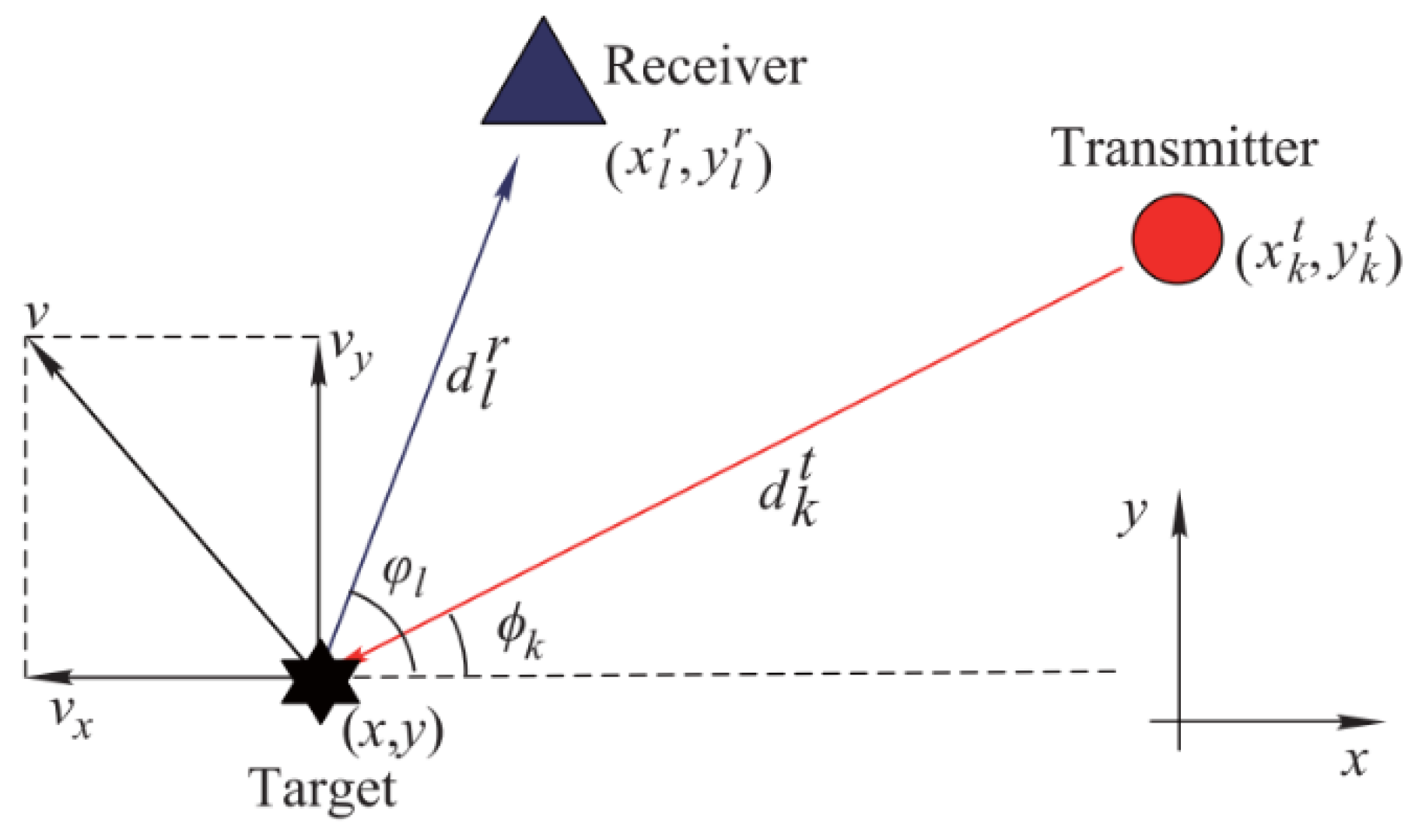
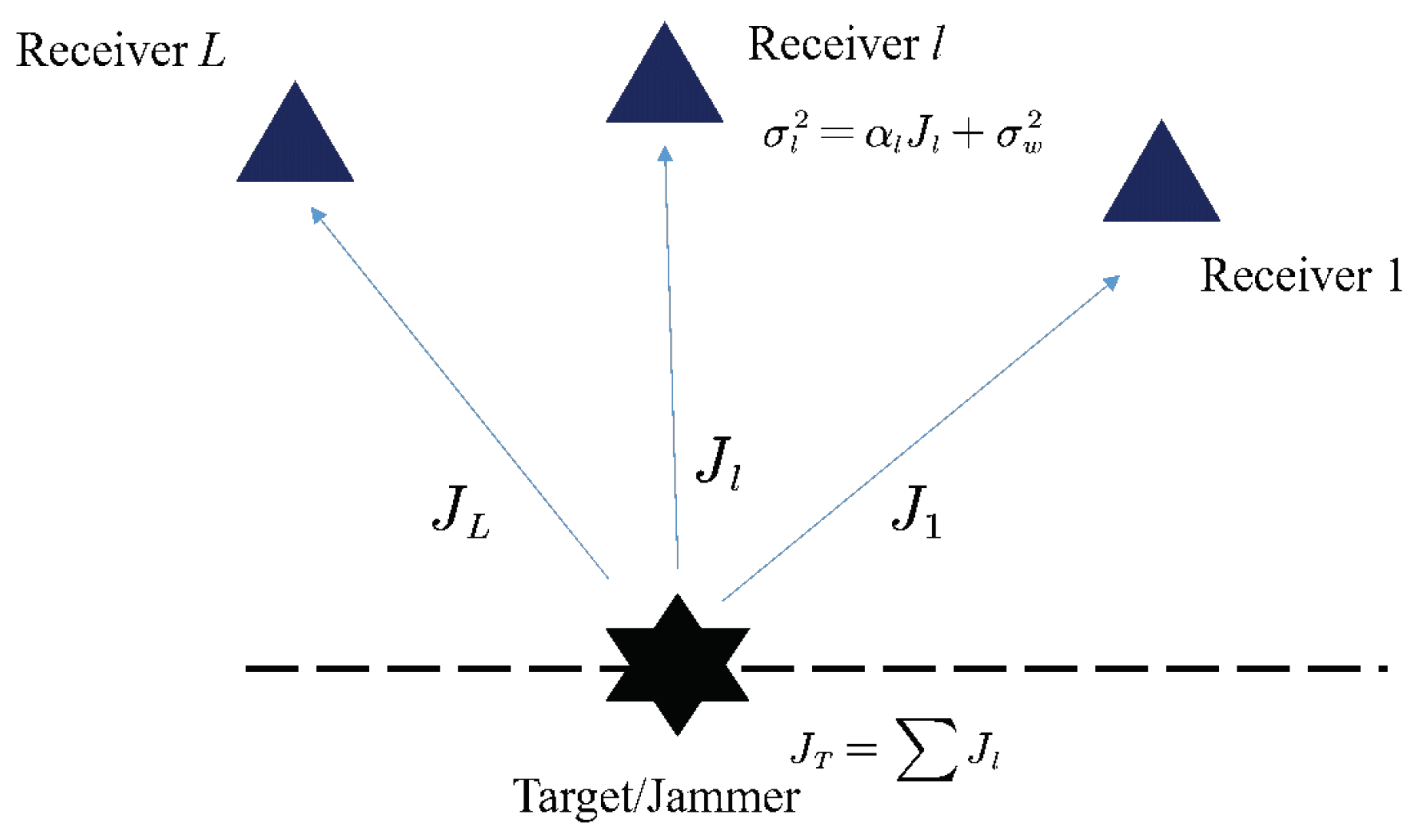
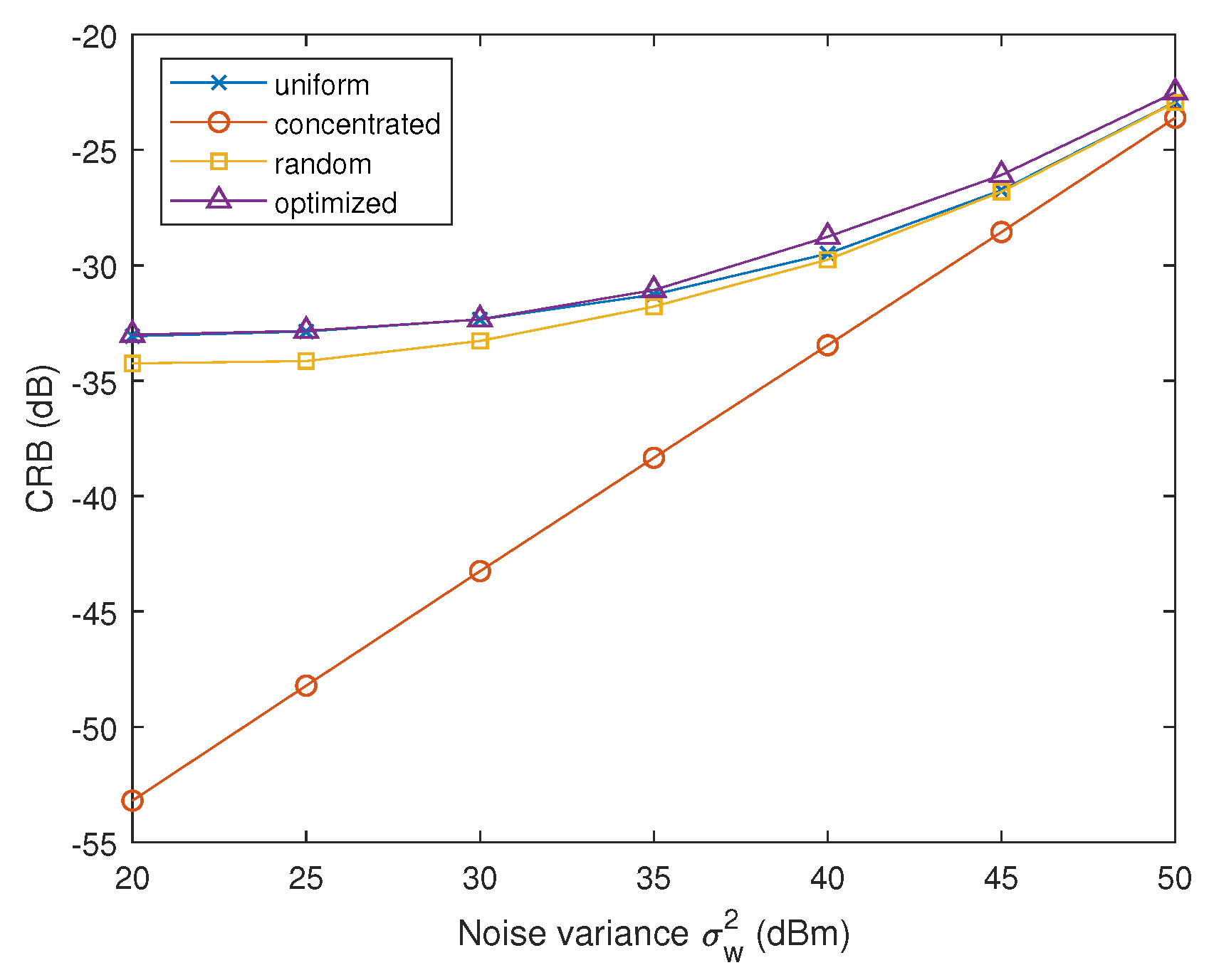
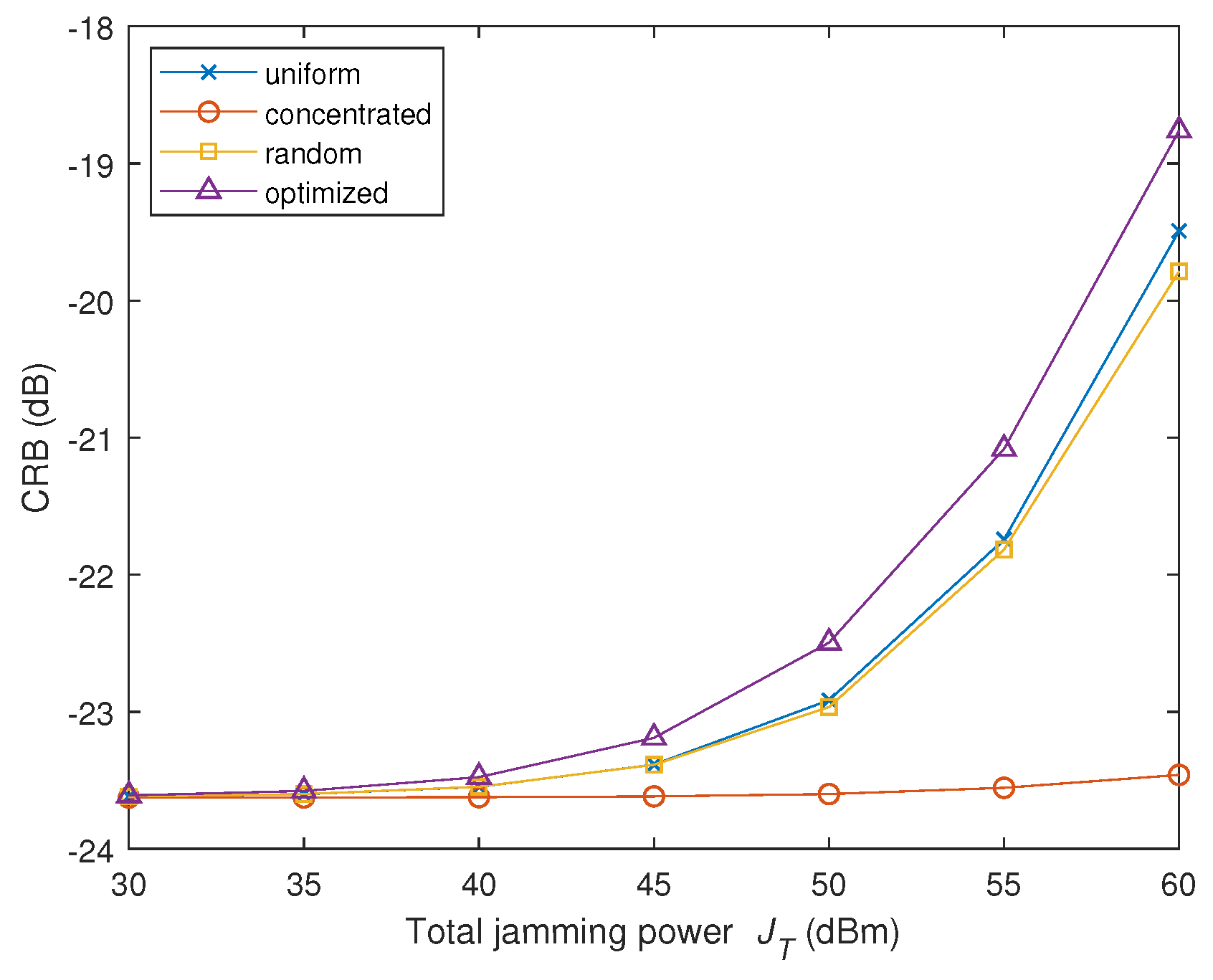

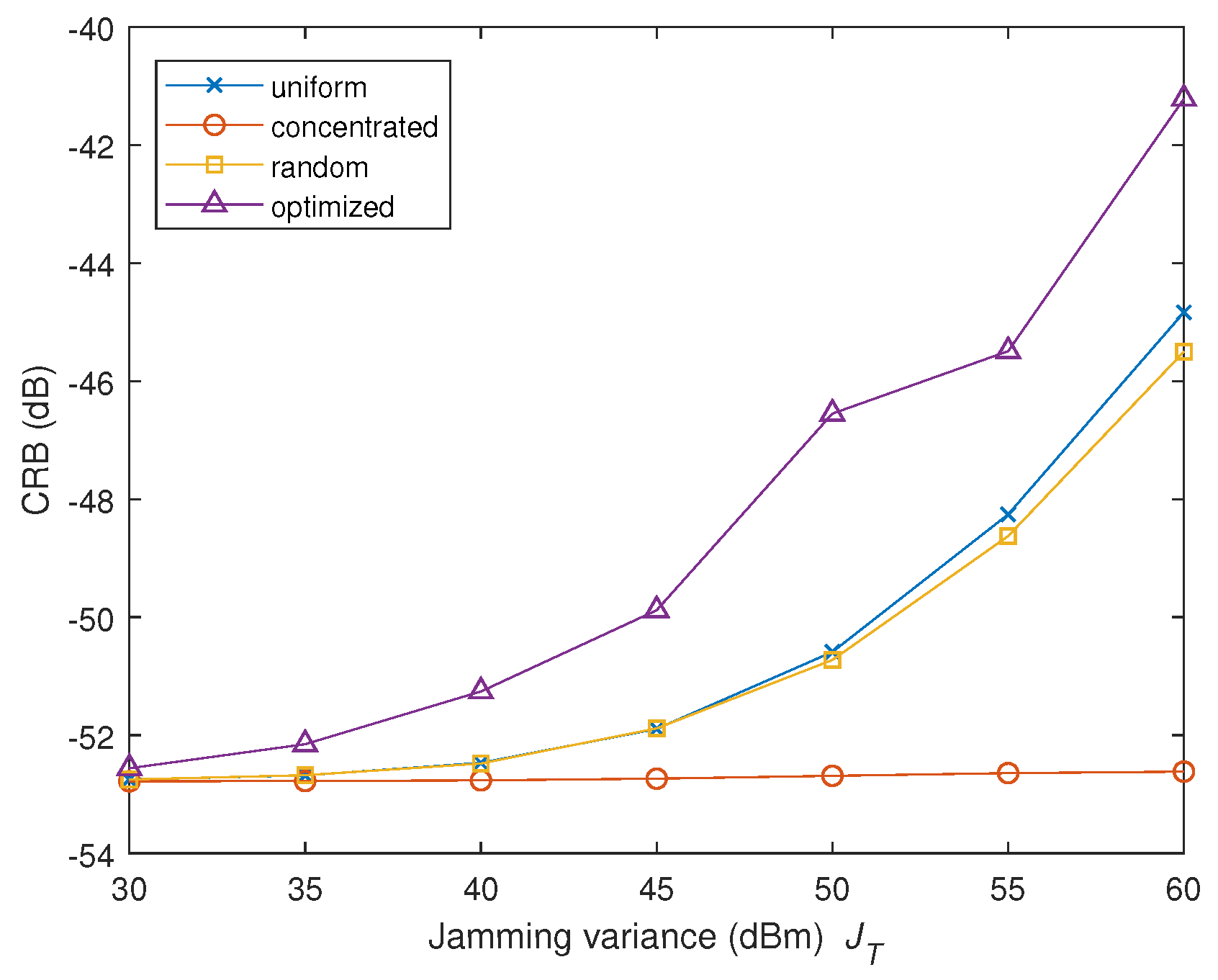
| Noise Variance (dBm) | Towards Node 1 (W) | Towards Node 2 (W) | Towards Node 3 (W) |
|---|---|---|---|
| 20 | 39.28 | 30.74 | 29.98 |
| 25 | 37.65 | 31.48 | 30.87 |
| 30 | 32.48 | 33.83 | 33.68 |
| 35 | 16.15 | 41.27 | 42.58 |
| 40 | 0 | 43.85 | 56.15 |
| 45 | 0 | 29.86 | 70.14 |
| 50 | 0 | 0 | 100 |
| Total Jamming Power (dBm) | Towards Node 1 (W) | Towards Node 2 (W) | Towards Node 3 (W) |
|---|---|---|---|
| 30 | 0 | 0 | 1 |
| 35 | 0 | 0 | 3.16 |
| 40 | 0 | 0 | 10 |
| 45 | 0 | 0 | 31.16 |
| 50 | 0 | 0 | 100 |
| 55 | 0 | 94.42 | 221.80 |
| 60 | 0 | 438.46 | 561.54 |
© 2019 by the authors. Licensee MDPI, Basel, Switzerland. This article is an open access article distributed under the terms and conditions of the Creative Commons Attribution (CC BY) license (http://creativecommons.org/licenses/by/4.0/).
Share and Cite
Zheng, G.; Na, S.; Huang, T.; Wang, L. A Barrage Jamming Strategy Based on CRB Maximization against Distributed MIMO Radar. Sensors 2019, 19, 2453. https://doi.org/10.3390/s19112453
Zheng G, Na S, Huang T, Wang L. A Barrage Jamming Strategy Based on CRB Maximization against Distributed MIMO Radar. Sensors. 2019; 19(11):2453. https://doi.org/10.3390/s19112453
Chicago/Turabian StyleZheng, Guangyong, Siqi Na, Tianyao Huang, and Lulu Wang. 2019. "A Barrage Jamming Strategy Based on CRB Maximization against Distributed MIMO Radar" Sensors 19, no. 11: 2453. https://doi.org/10.3390/s19112453
APA StyleZheng, G., Na, S., Huang, T., & Wang, L. (2019). A Barrage Jamming Strategy Based on CRB Maximization against Distributed MIMO Radar. Sensors, 19(11), 2453. https://doi.org/10.3390/s19112453





